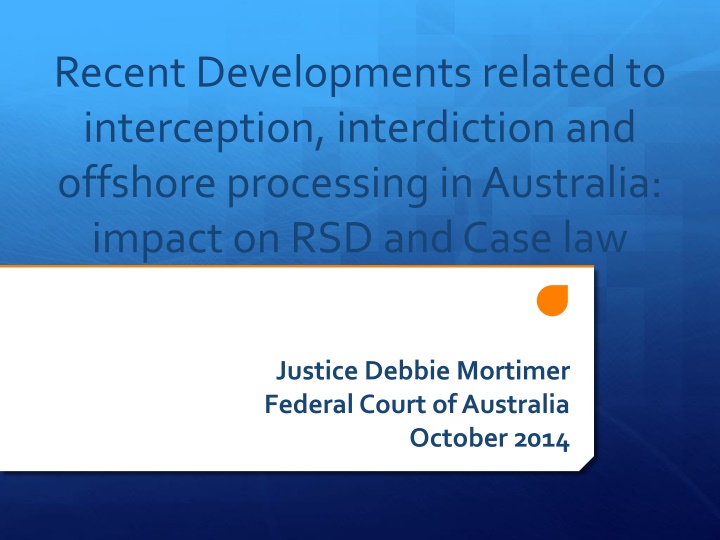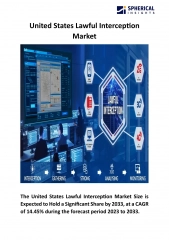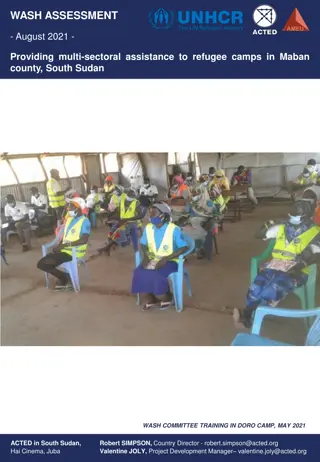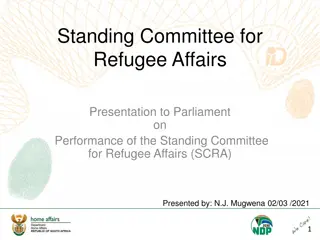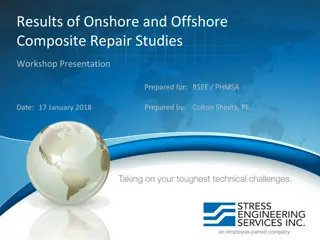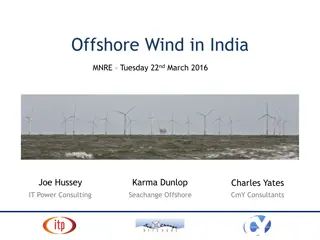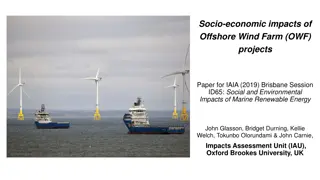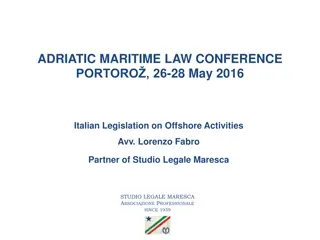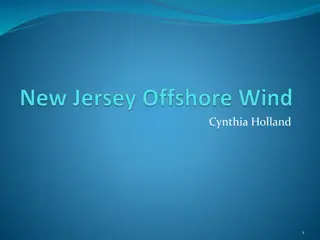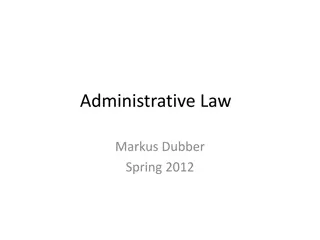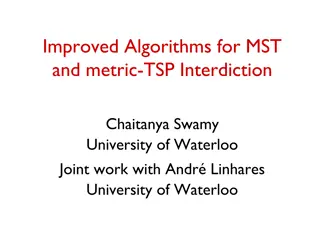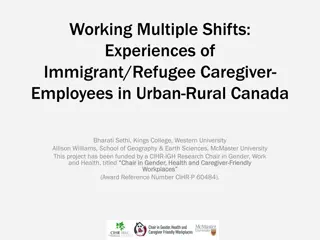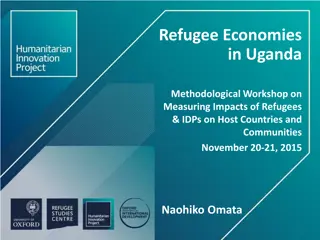Recent Developments in Australian Interception, Interdiction, and Offshore Processing: Impacts on Refugee Status Determination and Case Law
Recent developments in Australia regarding interception, interdiction, and offshore processing have had significant implications on refugee status determination (RSD) and case law. The discussion includes the impact of offshore processing policies since September 2001, changes in government policies, and the shift in approaches towards asylum seekers entering Australia. The legal structure, historical context, and key policy shifts are outlined, shedding light on the complex landscape of Australian immigration law and practices.
Download Presentation

Please find below an Image/Link to download the presentation.
The content on the website is provided AS IS for your information and personal use only. It may not be sold, licensed, or shared on other websites without obtaining consent from the author.If you encounter any issues during the download, it is possible that the publisher has removed the file from their server.
You are allowed to download the files provided on this website for personal or commercial use, subject to the condition that they are used lawfully. All files are the property of their respective owners.
The content on the website is provided AS IS for your information and personal use only. It may not be sold, licensed, or shared on other websites without obtaining consent from the author.
E N D
Presentation Transcript
Recent Developments related to interception, interdiction and offshore processing in Australia: impact on RSD and Case law Justice Debbie Mortimer Federal Court of Australia October 2014
Acknowledgements Raoul Renard, a JurisDoctor student in the Melbourne University Law School, Australia, provided much of the underlying research for this paper. Some facts taken from the Refugee Council of Australia s Timeline of major events in the history of Australia's Refugee and Humanitarian Program on the RCOA website
Basic legal structure in relation to asylum seekers entering Australia Key aspects of the Refugees Convention incorporated into Australian domestic law, including the Art 1A and 1F Entire asylum process (and all migration processes) regulated by statute, in detail Since 1992, basic legal division between lawful and unlawful non citizens, based on the possession of a valid visa. All nationals of other states, except New Zealanders, must obtain a visa before entry. Protection visas available onshore by application, containing Art 1A as a criterion for the grant of a visa Mandatory detention for unlawful non citizens, with discretionary exceptions. Mandatory removal obligations in respect of people who have failed the visa application process
Recent history of Australian offshore processing Offhsore processing (since Sept 2001, after the Tampacase) formed part of the federal government's policies on asylum seekers. Excision of parts of Australia from the migration zone (also 2001) has enabled the creation of different asylum assessment processes for people who arrive by boat. This was the introduction of the concept of offshore entry person defined by reference to where people first entered Australia. The offshore entry person concept, and a different processing regime in Australia remained, although offshore processing (in the sense of sending people to another country for processing) has come and gone and come again.
Subsequent policies Offshore processing abandoned by the Rudd government in December 2007 First proposed reintroduction by the Gillard government in July 2010 in proposed arrangement with East Timor, and then in May 2011 through an arrangement with Malaysia, involving Malaysia taking up to 800 asylum seekers who had arrived in Australia by boat , and Australia resettling 4,000 UNCHR assessed refuges from Malaysia
Legal issues which have arisen Differential treatment of people arriving by boat from people arriving by air in terms of access to protection and to Australian courts non statutory processes and offshore entry persons (Plaintiff M 61) Proposed removal of people from Australian territory for offshore processing and detention (Plaintiff M 70) Interception at sea, powers to remove directly (or turn back) to a third country, without any assessment, including one where people may claim to have a well founded fear of persecution (Plaintiff S 169/2014, CPCF)
The High Courts approach to these issues Only Court with entrenched judicial supervision through s 75 of the Constitution. Proportionately , a high volume of the High Court s workload, both original jurisdiction and appeal, is migration cases and mostly about asylum seekers Has developed Australian administrative law over the last decade or more principally through the migration jurisdiction. Especially in the last 5 years or so, the High Court has developed a coherent approach to the interpretation of the Migration Act which is more firmly grounded, expressly and impliedly, in Australia s Convention obligations, especially concepts of protection and non refoulement. It is this latter development which is resulting in the implementation of government policies, whether through administrative decision making, executive action or legislation, being from the government s perspective less successful than desired. That in turn has driven considerable legislative changes in the last 12-18 months in particular.
Plaintiff M61/2010 v Commonwealth ( Offshore Processing Case ) [2010] HCA 41 The plaintiff arrived at Christmas Island by boat, and was as an offshore entry person under the Migration Act. He could not make a valid application for a protection visa. The Minister had a personal statutory power to lift the bar and allow him to make an application if he thought it was in the public interest to do so. The Government had established a process to assess people s claims, first by a departmental officer, then by an Independent Merits Reviewer , contracted by the Government for this purpose. Recommendations were then made to the Minister. Plaintiff argued the High Court could review the lawfulness of recommendations under that process, and said he had been denied procedural fairness, and that the process was unlawful because those conducting it did not ( in accordance with government s instructions to them) consider themselves bound by the Migration Act ad by Australian law about assessing refugee claims. The Commonwealth argued that the processes were exercises of non-statutory executive power and not amenable to review in the way the plaintiff said. Court held, unanimously, that because the Minister has decided to consider exercising his powers in every case where an offshore entry person claims to be owed protection obligations, the processes were steps taken under and for the purposes of the Migration Act. The processes prolonged the plaintiff's detention and was a direct impact on his rights and interests. Those processes had to be conducted in a procedurally fair way and in accordance with Australian law.
Consequences January 2011: the Government accepts offshore entry people whose claims are rejected should have access to judicial review. The two tier assessment process was thereafter conducted in a way which was consistent with the High Court s decision in M61, and people who failed had access to judicial review in the usual way. Eventually, the federal government brought the merits review decision making back into the mainstream review system, by giving offshore entry people access to the RRT
Plaintiff M 70 v Commonwealth (Malaysian Declaration Case ), [2011] HCA 32 Under the Migration Act (and since 2001) the path to offshore processing involved a Ministerial declaration of a specific country, to which people could be taken. The Minister could declare that a specific country: (i) provided access, for persons seeking asylum, to effective procedures for assessing their need for protection; and (ii) provided protection for persons seeking asylum, pending determination of their refugee status; and (iii) provided protection to persons who were given refugee status, pending their voluntary repatriation to their country of origin or resettlement in another country; and (iv) met relevant human rights standards in providing that protection. (s 198A(3)) An officer was then empowered to take an offshore entry person to such a country, keeping them in detention to do so ( s 198A(3)) Previously, this is how people were sent to Nauru in the early 2000 s.
Plaintiff M 70 (cont.) In 2011, when the federal government wished to re-introduce offshore processing, Malaysia was the subject of a declaration by the Minster. It happened very quickly, and once Malaysia was declared, the federal government moved fast to move the first group of boat arrivals. All processing under the M61 process was stopped. Aim was all arrivals would be sent to Malaysia. Two plaintiffs one adult man, one unaccompanied minor, a young boy. Both from Afghanistan. Plaintiffs argued the Minister s declaration of Malaysia was unlawful because, it was not a signatory to the Refugees Convention, and there was no evidence it had a domestic legal framework to secure the protections set out in s 198A.
Plaintiff M 70 (cont.) Four judges agreed (Gummow, Hayne, Crennan, Kiefel and Bell JJ A fifth ( Chief Justice French) held that the Minister had, at least, to be satisfied that Malaysia could offer such protections and on the evidence the Minister did not inquire into that matter. All turned on the wording of s 198A, and the evidence of what was before the Minister when he made his declaration.
Plaintiff M 70 (cont.) The court also held that there were special legal requirements, under another piece of federal legislation called the Immigration (Guardianship of Children) Act 1946 (Cth) The Minister was, under this Act, the guardian of all unaccompanied minors arriving in Australia. Court held the Minister s consent was needed before such a child could be removed, and Minister would have to be satisfied removal was in his interests.
Consequences: legislation Sept Oct 2011, Government attempted to pass legislation to change the effect of Plaintiff M70, but could not secure the bipartisan support needed. Instead, large numbers of offshore entry people were released on temporary visas into the community while their claims were processed Then: Migration Legislation Amendment (Regional Processing and Other Measures) Act 2012 (Cth) amending the Migration Act 1958 (Cth) to replace the existing framework for taking offshore entry persons to another country for assessment of their claims to be refugees; and Immigration (Guardianship of Children) Act 1946in relation to the making and implementation of any decision to remove, deport or take a non-citizen child from Australia.
Government's explanation After referring to the High court s decision in Plaintiff M70, the government's explanation of the new legislation was: The amendments will ensure that the Government is able to implement the regional processing arrangements that are now envisaged. The amendments will ensure that the government of the day can determine the border protection policy that it believes is in the national interest. It will also allow for the regional cooperation framework envisaged in the Expert Panel s report to be implemented. (Revised Explanatory Memorandum, Migration Legislation Amendment
Changes made Replace the existing framework in the Migration Act for taking offshore entry persons to another country, giving effect to recommendation 7 of the Expert Panel s report Section 198AB(2) The only condition for the exercise of the power under subsection (1) is that the Minister thinks that it is in the national interest to designate the country to be a regional processing country. Guardianship obligations under the IGOC Act do not affect the operation of the Migration Act, particularly in relation to the making and implementation of any decisions to remove, deport or take a non-citizen child from Australia, and
Consequences: executive On 29 August 2012 the Australian Government signed an MOU with the Government of Nauru and on 8 September 2012 the Government signed an updated MOU with the PNG Government. The first transfer of asylum seekers to Nauru occurred on 14 September 2012 and to PNG on 21 November 2012 Further agreement with PNG and Nauru allowing for not just processing but permanent resettlement in those countries
Consequences: the Expert Panel Key contribution to policy formulation and implementation through legislation. Established in June 2012 after the Malaysian Declaration case. Three distinguished members from defence force, national security and asylum seeker support areas. Terms of reference included :how best to prevent asylum seekers travelling to Australia by boat and the development of an inter-related set of proposals in support of asylum seeker issues, given Australia s right to maintain its borders .
Recommendations (13 August 2012): selection of those relevant to my topic only The application of a no advantage principle to ensure that no benefit is gained through circumventing regular migration arrangement. An increase of Australia s Humanitarian Program to 20,000 places per annum, Several recommendations about capacity building in the region, bilateral cooperation with countries such as Indonesia and Malaysia, continuation of arrangements to return people arriving by boat to Malaysia, despite M 70 Regional processing in Nauru and PNG, boat turn backs endorsed if safe to do so. Remove or change family reunion concessions and family sponsorship for irregular maritime arrivals
Implementation The Australian Government endorsed in principle all 22 of the Expert Panel s recommendations, and immediately implemented many of them. From this point until July 2013, the processing of asylum claims made by people who arrived by boat on or after 13 August 2012 was effectively suspended to implement the no advantage approach. When resumed in July 2013, approximately 20,000 cases in backlog.
From November 2012 Following a significant increase in boat arrivals, the Australian Government acknowledged it could not transfer all arrivals to Nauru or PNG Policy change to process some asylum seekers in Australia, but will still be subject to the no advantage test. This means that they will be released into the community on bridging visas but will not have the right to work. If they are found to be refugees, they will remain on bridging visas and will not receive a permanent visa until they have waited for the same length of time that they would have waited, if they had applied for resettlement overseas. They may also be transferred to Nauru or Manus Island at any time.
A notable gap in litigation Only one, unsuccessful , challenge to offshore detention and processing by a person held offshore Plaintiff S156-2013 v Minister for Immigration and Border Protection [2014] HCA 22 (18 June 2014) Challenged the positional validity of laws in the Migration authorizing the removal of an asylum seeker to Manus Island and the Minister s designation of PNG as a regional processing country Laws and Minister s designation held to be valid.
Maritime Powers Act 2013 (Cth) Introduced as a Bill on 30 May 2012, passed 16 May 2013 Provisions removed from Migration Act and inserted into new legislation dealing with interception, boarding and detention of vessels and people at sea.
Interception at sea of Sri Lankan Tamils: CPCF Section 72 of the Maritime Powers Act 2013 (Cth) ( Maritime Powers Act ) makes provision for the detention and movement of persons on a vessel detained by maritime officers (which include members of the Australian Defence Force and Customs officers). Section 72(4) provides as follows: A maritime officer may detain the person and take the person, or cause the person to be taken: (a) to a place in the migration zone; or (b) to a place outside the migration zone, including a place outside Australia.
CPCF: Facts The plaintiff is a Tamil Sri Lankan who claims to have refugee status. He and several family members of his were among 157 people aboard a vessel intercepted by an Australian border protection vessel on 29 June 2014. That interception occurred in the Indian Ocean near Christmas Island, in the contiguous zone to Australia s territorial sea. After the Indian vessel had a mechanical failure, the detainees were transferred to the Australian vessel and were then detained aboard it.
CPCF cont. On 1 July 2014 the National Security Committee of Cabinet decided that the detainees should all be taken to India. There would be no assessment of any claims they had to protection. The detainees remained aboard the Australian vessel while it travelled through international waters and later waited near India while diplomatic negotiations took place .
CPCF cont. High Court proceedings issued on 7 July 2014, heard 15 October 2014. Eventually the Minister then decided to take the detainees into Australia s migration zone instead of to India. The detainees remained aboard the Australian vessel until 27 July 2014, when they were taken to the Cocos (Keeling) Islands and detained under the Migration Act 1958 (Cth).
Plaintiff's Arguments the power to take conferred by s. 72(4) of the MPA was constrained such that the places to which the plaintiff could lawfully be taken were confined to places to which the plaintiff could be taken consistently with Australia's non- refoulement obligations An executive power to prevent non-citizens entering Australia, absent statutory authority, does not exist; if it did exist, it was abrogated by the MPA; and even if it did exist and was not abrogated, that power is subject to constraints that have been infringed in the current matter. ([5])
UNHCR argument (granted limited leave to intervene) the weight of opinion at international law is that the principle of non-refoulement, including under Art 33(1) of the Refugee Convention applies, wherever a State exercises jurisdiction, and whether it is exercised de jure or de facto. ([ 26]) [emphasis added] Australia cannot remove a person to a country unless and until Australia is satisfied that that country is not a place where the person has a well-founded fear of persecution on one of the five Refugee Convention grounds, and has satisfied itself that the country - at a minimum -will afford the person protection against refoulement. (51])
Commonwealth argument Section 72(4) is not limited by reference to whether the domestic law of the place to which the person is taken implements or confers the benefit of the "non-refoulement obligations" (][9]) Also puts an argument squarely based on the Tampa decision in the Full Federal Court ( Tampa never went to the High Court) about the federal government's executive power under s 61 of the Australia Constitution
Commonwealth argument #2 The Commonwealth Executive had power to prevent the Indian vessel and the persons on board from entering Australian territorial waters, including by boarding and detaining the vessel. Once detained, in circumstances where the vessel was no longer seaworthy, it was necessary, to make the exclusion effective, to take the persons from the vessel to a place outside Australia. That was done by attempting to take the persons to the place from which that vessel had departed. ([74])
Government reaction to CPFC and other proposed further legislative changes Migration and Maritime Powers Legislation Amendment (Resolving the Asylum Legacy Caseload) Bill 2014 Second Reading Speech date: 25 September 2014 This Bill proposes substantial amendments to both the Maritime Powers Act and the Migration Act
Key changes, relevant to this topic The perceived importance of this legislation can be seen through the explanatory memorandum (some 251 pages long) which states that the Bill fundamentally changes Australia s approach to managing asylum seekers
Proposed changes to the Maritime Powers Act #1 Maritime powers may be exercised in and outside Australia if the Minister administering the Maritime Powers Act has determined this should be the case . People and vessels can be detained and moved to another country, a place just outside a country, or to a place that is not a country (like another vessel?). There does not need to be any arrangement in place about the reception of vessels or people with the country to which the vessels or people are taken. Rules of natural justice do not generally apply The exercise of most of these powers cannot be invalidated because a court considers there has been a failure to consider, properly consider, or comply with Australia s international obligations, or the international obligations or domestic law of any other country
Proposed changes to the Maritime Powers Act #2 Section 72 powers (and a range of related provisions) operate in their own right, and that there is no implication to be drawn from the Migration Act, particularly from the existence of the regional processing provisions Decisions relating to operational matters cannot be subjected to statutory judicial review provisions under Australian law Note, the Parliament is unable to exclude the High Court s jurisdiction under s 75 of the Constitution, but can exclude the jurisdiction of the federal courts, because they are statutory courts.
Proposed changes to the Migration Act #1 create a new fast track assessment process and remove access to the Refugee Review Tribunal (RRT) for fast track applicants, who are defined as unauthorised maritime arrivals (UMAs) who entered Australia on or after 13 August 2012 and made a valid application for a protection visa (retrospective) require the Minister to refer fast track reviewable decisions to the Immigration Assessment Authority (IAA) which will conduct a limited merits review on the papers and either affirm the fast track reviewable or remit the decision for reconsideration in accordance with prescribed directions or recommendations (IAA to be located within RRT)
Proposed changes to the Migration Act #2 clarify the availability of the removal powers independent of assessments of Australia s non- refoulementobligations; clarify, with retrospective effect, that children born to unauthorised maritime arrivals and transitory persons under the Migration Act either in Australia or in a regional processing country are also UMAs or transitory persons for the purposes of the Migration Act. Retrospectively invalidate, subject to personal Ministerial power, visa applications on behalf of such children.
Proposed changes to the Migration Act #3 Government can place a statutory limit on the number of protection visas granted in a programme year. Repeal the current requirement for applications for protection visas to be decided in 90 days Reintroduce temporary protection visas, and convert, retrospectively, existing applications for permanent protection to application for temporary protection
Proposed changes to the Migration Act#4 Reference to the Refugees Convention in the criteria for a protection visa are to be removed. Most other references to the Refugees Convention in the Act also removed. The entire definition of who is a refugee and the basis for it, are to be defined in the statute, not necessarily consistently with the Convention and Convention jurisprudence
